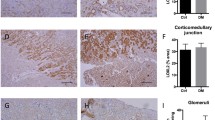Abstract
Lipid abnormalities have been implicated in the pathogenesis of glomerulosclerosis in experimental models of kidney disease. In previous studies it has been shown that Adriamycin-induced nephropathy is associated with reduced activities of glomerular proteinases. This observation led to the hypothesis that reduced proteolytic activities may be responsible for mesangial protein accumulation, which ultimately leads to global sclerosis of the glomerular tuft. The aim of the present study was to investigate whether lovastatin treatment, which prevents progressive glomerulosclerosis in experimental nephrotic syndrome, would also have an effect on glomerular proteinase activities. Adriamycin administration resulted in a persistent nephrotic syndrome with gross proteinuria (377±26 mg/24 h), hypoalbuminemia (2.1±0.12 vs. 2.8±0.02 g/dl), hypercholesterolemia (575±74 vs. 68±1.5 mg/dl) and elevated triglyceride levels (1,155±78 vs. 57±8 mg/dl). Glomerular azocaseinolytic activities both at pH 5.4 (−21%) and 7.4 (−37%) were significantly reduced. In contrast to human subjects, nephrotic rats that were treated with lovastatin displayed reduced triglyceride levels (767±134 mg/dl); their serum cholesterol, however, remained unchanged. In terms of glomerular proteolytic enzyme activities, the decline in azocaseinolysis at both pH values was, at least partly, prevented by lovastatin. On the basis of these data, it appears that the beneficial effect of lovastatin on the evolution of glomerulosclerosis in the nephrotic rat is associated with the conservation of glomerular proteolytic activities.
Similar content being viewed by others
References
Keane WF (1994) Lipids and the kidney. Kidney Int 46:910–920
Diamond JR, Karnovsky UJ (1988) Focal and segmental glomerulosclerosis: Analogies to atherosclerosis. Kidney Int 33:917–924
Kasiske BL, O'Donnell MP, Schmitz PG, Kim Y, Keane WF (1990) The renal injury of dietinduced hypercholesteriemia in rats. Kidney Int 37:880–891
Diamond JR, Karnovsky MJ (1987) Exacerbation of chronic aminonucleoside nephrosis by dietary cholesterol supplementation. Kidney Int 32:617–678
Baxter JH (1962) Hyperlipoproteinemia in nephrosis. Arch Int Med 109:742–757
Harris KPG, Purkerson ML, Yates J, Klahr S (1990) Lovastatin ameliorates the development of glomerulosclerosis and uremia in experimental nephrotic syndrome. Am J Kidney Dis 15:16–23
Klahr S, Schreiner G, Ichikawa I (1988) The progression of renal disease. N Engl J Med 318:1657–1666
Grond J, Koudstaal J, Elema D (1985) Mesangial function and glomerular sclerosis in rats with aminonucleoside nephrosis. Kidney Int 27:405–410
Davis M, Martin J, Thomas GJ, Coles GA, Lovett DH (1987) Degradation of glomerular extracellular matrices. In: Price RG, Hudson B (eds) Renal basement membranes in health and disease. Academic Press, London, pp 181–201
Schaefer RM, Paczek L, Huang S, Teschner M, Schaefer L, Heidland A (1992) Role of glomerular proteinase in the evolution of glomerulosclerosis. Eur J Clin Chem Clin Biochem 30:641–646
Paczek L, Teschner M, Schaefer RM, Kovar J, Romen W, Heidland A (1992) Intraglomerular proteinase activity in Adriamycin-induced nephropathy. Nephron 60:81–86
Schaefer L, Schaefer RM, Ling H, Teschner M, Heidland A (1994) Renal proteinases and kidney hypertrophy in experimental diabetes. Diabetologia 37:567–571
Okuda S, Ohy O, Touruda H, Onoyama K, Fujimi S, Fuhishima M (1986) Adriamycin-induced nephropathy as a model of chronic progressive glonerular disease. Kidney Int 29:502–510
Spiro RG (1967) Studies on the renal glomerular basement membrane. Preparation and chemical composition. J Biol Chem 242:1915–1919
Lange J, Wakil A, Zimmermann M, Ansorg S, Bohley P, Kirschke H, Wiederanders D (1973) Aktivitätsbestimmung proteolytischer Enzyme mit Azocasein also Substrat. Acta Biol Med Germ 31:1–18
Lowry OH, Rosebrough NJ, Farr AC, Randall RJ (1951) Protein measurements with the folin phenol reagent. J Biol Chem 193:265–275
Maniatis T, Fritsch E, Sambrook J (1982) Molecular cloning: a laboratory manual. Cold Spring Harbor Laboratory, Cold Spring Harbor, pp 458–568
Ding GH, Pesek-Diamond I, Diamond JR (1993) Cholesterol, macrophages, and gene expression of TGF-beta-1 and fibronectin during nephrosis. Am J Physiol 264:F577-F584
Joles J, Willekes-Koolschijn N, Koomans H, Tol A van, Geelhoed-Mieras T, Crommelin B, Bloois L van, Cohen L, Goiffioen M (1992) Subcutaneous administration of HMG-CoA-reductase inhibitor in hyperlipidaemic and normal rats. Lab Anim 26:269–280
Gröne H-J, Miller B, Walli AK, Eisenhauer T, Gröne E, Seidel D (1992) Reduktion einer Lipid-Glomerulopathie durch den HMG-CoA-Reduktase-Inhibitor Lovastatin im Meerschweinchen. Ein Effekt ohne wesentlichen Abfall des Plasmacholesterins. 23rd Congress of the Gesellschaft für Nephrologie, Nieren- und Hochdruckkrankheiten, Hannover 1992, abstrasts, p278
Kasiske BL, O'Donnell MP, Cleary MP, Keane WF (1988) Treatment of hyperlipidemia reduces glomerular injury in obese Zucker rats. Kidney Int 33:667–672
O'Donnell MP, Kasiske BL, Kim Y, Atluru D, Keane WF (1993) Lovastatin inhibits parliferation of rat mesangial cells. J Clin Invest 91:83–87
Gujiarro C, O'Donnell MP, Kasiske BL, Kim Y, Atluru D, Keane WF (1993) Differential effects of lovastatin on human mesangial cell mRNA for cytokines involved in proliferation and matrix turnover (abstract). J Am Soc Nephrol 4:770
Schaefer L, Teschner M, Hong L, Oldakowska U, Heidland A, Schaefer RM (1994) The aging rat kidney displays low glomerular and tubular proteinase activities. Am J Kidney Dis 24:499–504
Tamaki K, Okuda S, Ando T, Iwamoto T, Nakayama M, Fujishima M (1994) TGF-beta 1 in glomerulosclerosis and interstitial fibrosis of adriamycin nephropathy. Kidney Int 45:525–536
Border WA, Ruoslahti E (1992) TGF-β in disease: the dark side of tissue repair. J Clin Invest 90:1–7
Edwards DR, Murphy G, Reynolds JJ (1987) TGF-β modulates the expression of collagenase and metalloproteinase inhibitor. EMBO J 6:1899–1904
Laiho M, Saksela O, keski-Oja J (1987) TGF-β induction of type-1 plasminogen activator inhibitor. J Biol Chem 262:17467–17474
Author information
Authors and Affiliations
Rights and permissions
About this article
Cite this article
Teschner, M., Paczek, L., Schaefer, L. et al. Lovastatin ameliorates depressed intraglomerular proteolytic activities in experimental nephrotic syndrome. Res. Exp. Med. 194, 349–356 (1994). https://doi.org/10.1007/BF02576397
Received:
Accepted:
Issue Date:
DOI: https://doi.org/10.1007/BF02576397




